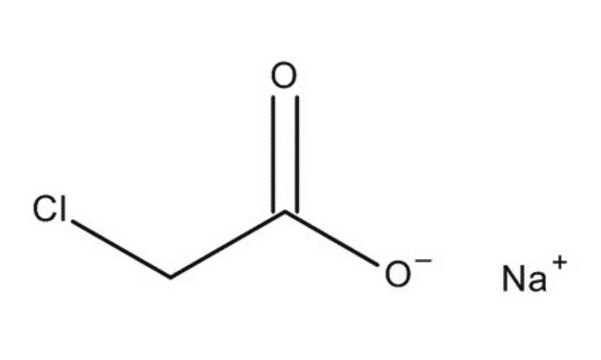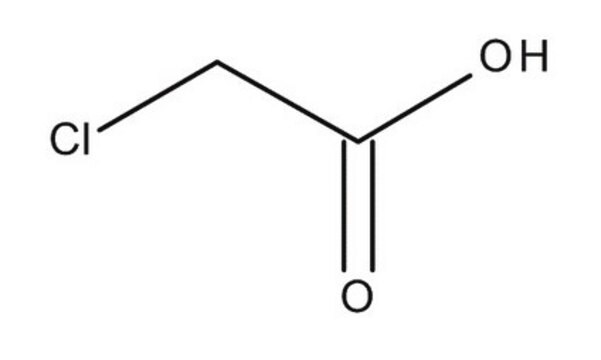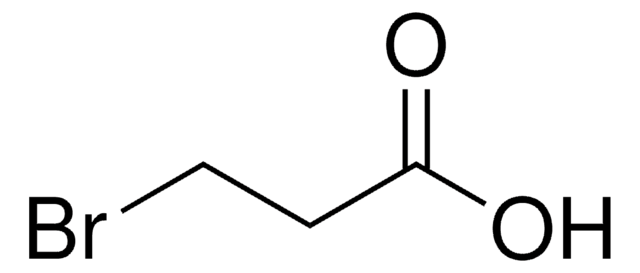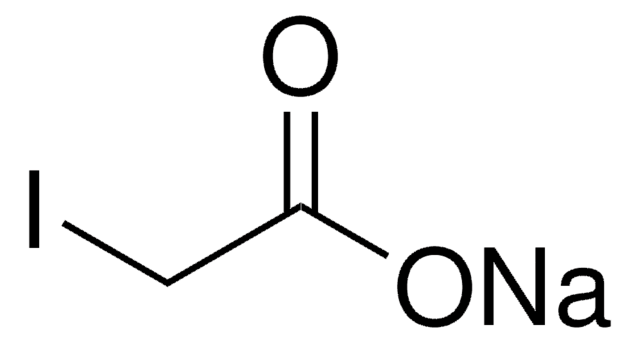291773
Sodium chloroacetate
98%
Sinônimo(s):
Chloroacetic acid sodium salt
About This Item
Produtos recomendados
Nível de qualidade
Ensaio
98%
Formulário
powder or chunks
pf
199 °C (dec.) (lit.)
cadeia de caracteres SMILES
[Na+].[O-]C(=O)CCl
InChI
1S/C2H3ClO2.Na/c3-1-2(4)5;/h1H2,(H,4,5);/q;+1/p-1
chave InChI
FDRCDNZGSXJAFP-UHFFFAOYSA-M
Procurando produtos similares? Visita Guia de comparação de produtos
Aplicação
- Nano-copper ions assembled cellulose-based composite with antibacterial activity for biodegradable personal protective mask.: This study explores the creation of a nano-copper ions cellulose-based composite, showcasing its potential antibacterial properties and application in biodegradable personal protective masks (Shao et al., 2023).
- Effective extraction of fluoroquinolones from water using facile modified plant fibers.: This article investigates the use of modified plant fibers for the efficient extraction of fluoroquinolones from water, highlighting the utility of sodium chloroacetate in the modification process (Zhang et al., 2022).
- Sodium Chloroacetate Modified Polyethyleneimine/Trimesic Acid Nanofiltration Membrane to Improve Antifouling Performance.: The study details the improvement of antifouling performance in nanofiltration membranes through modification with sodium chloroacetate (Gu et al., 2021).
- Preparation of BiOCl/Bi(2)WO(6) Photocatalyst for Efficient Fixation on Cotton Fabric: Applications in UV Shielding and Self-Cleaning Performances.: This research focuses on the application of a BiOCl/Bi(2)WO(6) photocatalyst in UV shielding and self-cleaning performances on cotton fabric, employing sodium chloroacetate in the preparation process (Chen et al., 2021).
Palavra indicadora
Danger
Frases de perigo
Declarações de precaução
Classificações de perigo
Acute Tox. 3 Oral - Aquatic Acute 1 - Eye Irrit. 2 - Skin Irrit. 2
Código de classe de armazenamento
6.1D - Non-combustible acute toxic Cat.3 / toxic hazardous materials or hazardous materials causing chronic effects
Classe de risco de água (WGK)
WGK 3
Ponto de fulgor (°F)
518.0 °F - closed cup
Ponto de fulgor (°C)
270 °C - closed cup
Escolha uma das versões mais recentes:
Já possui este produto?
Encontre a documentação dos produtos que você adquiriu recentemente na biblioteca de documentos.
Os clientes também visualizaram
Nossa equipe de cientistas tem experiência em todas as áreas de pesquisa, incluindo Life Sciences, ciência de materiais, síntese química, cromatografia, química analítica e muitas outras.
Entre em contato com a assistência técnica



















